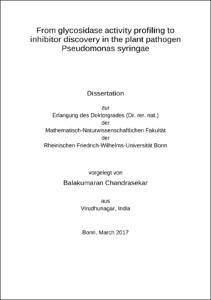From glycosidase activity profiling to inhibitor discovery in the plant pathogen Pseudomonas syringae

From glycosidase activity profiling to inhibitor discovery in the plant pathogen Pseudomonas syringae

| dc.contributor.advisor | van der Hoorn, Renier | |
| dc.contributor.author | Chandrasekar, Balakumaran | |
| dc.date.accessioned | 2020-04-25T02:55:29Z | |
| dc.date.available | 2020-04-25T02:55:29Z | |
| dc.date.issued | 25.05.2018 | |
| dc.identifier.uri | https://hdl.handle.net/20.500.11811/7568 | |
| dc.description.abstract | Retaining glycosidases are important in plants for various biological processes. Plant genomes encode for more than 200 retaining glycosidases but the physiological roles and activities of many remain poorly understood. We established glycosidase activity profiling in plants using activity-based probes based on cyclophellitol-aziridine. These probes targeted a diversity of glycosidases belonging to different GH families in leaf extracts of Arabidopsis thaliana and in the cell wall proteome of Nicotiana benthamiana. When applied to plants infected with the bacterial pathogen Pseudomonas syringae, we discovered that the activity of a cell wall associated beta-galactosidase (BGAL) is suppressed during infection. We also introduce convolution ABPP, a novel inhibitor discovery approach that revealed that the suppression of BGAL is caused by a small, heat-stable inhibitor that is produced by the pathogen. Bacterial genetics together with biochemical approaches indicate that trihydroxy piperidine (THP), an imino sugar might be the BGAL inhibitor produced by the pathogen. Trihydroxy piperidine (THP) was detected during infection and in bacterial cultures using GC-MS and HRMS. Pathogen growth assays using the BGAL inhibitor mutants indicate that BGAL inhibitor production is important for the virulence of PtoDC3000, whereas depletion of BGAL using virus-induced gene silencing (VIGS) increased bacterial growth, indicating the discovery of an important immune enzyme that is suppressed by pathogenic bacteria. Furthermore, two candidate PLCPs that might be required for processing the BGAL enzyme in Nicotiana benthamiana were identified using VIGS. In addition, a new tool for functional classification of JJB-labeled glycosidases has been introduced based on product inhibition of glycosidases. Moreover, two interesting observations during my PhD program are also documented. First, increased glycosidases activities observed in the growth medium of a PtoDC3000 mutant is due to the disruption of a gene encoding for an ABC transporter. Second, unexpected inhibitory effects of commonly used antibiotics on plant glycosidases were discovered. | |
| dc.description.abstract | Vom Glycosidase-Aktivitäts-Profiling zum Inhibitor-Nachweis im Pflanzenpathogen Pseudomonas syringae Haltende Glycosidasen sind in Pflanzen für verschiedene biologische Prozesse wichtig. Pflanzengenome kodieren für mehr als 200 zurückhaltende Glycosidasen, aber die physiologischen Rollen und Aktivitäten von vielen bleiben nur unzureichend verstanden. Wir haben das Profilieren von Glycosidase-Aktivität in Pflanzen unter Verwendung von auf Aktivität basierenden Sonden basierend auf Cyclophellitaziridin etabliert. Diese Sonden zielen auf eine Vielfalt von Glykosidasen, die zu verschiedenen GH-Familien in Blattextrakten von Arabidopsis thaliana und im Zellwandproteom von Nicotiana benthamiana gehören. Bei Anwendung auf Pflanzen, die mit dem bakteriellen Pathogen Pseudomonas syringae infiziert waren, entdeckten wir, dass die Aktivität einer Zellwand-assoziierten Beta-Galactosidase (BGAL) während der Infektion unterdrückt wird. Wir führen auch Faltung ABPP ein, einen neuartigen Ansatz zur Entdeckung von Inhibitoren, der zeigte, dass die Unterdrückung von BGAL durch einen kleinen, hitzestabilen Inhibitor verursacht wird, der von dem Pathogen produziert wird. Bakterielle Genetik zusammen mit biochemischen Ansätzen deuten darauf hin, dass Trihydroxypiperidin (THP), ein Iminozucker, der BGAL-Inhibitor sein könnte, der von dem Pathogen produziert wird. Trihydroxypiperidin (THP) wurde während der Infektion und in Bakterienkulturen mittels GC-MS und HRMS nachgewiesen. Pathogenwachstumsassays unter Verwendung der BGAL-Inhibitormutanten zeigen, dass die BGAL-Inhibitorproduktion für die Virulenz von PtoDC3000 wichtig ist, wohingegen die Abreicherung von BGAL unter Verwendung von virusinduziertem Gen-Silencing (VIGS) das Bakterienwachstum erhöhte, was auf die Entdeckung eines wichtigen Immunenzyms hinweist, das unterdrückt wird pathogenen Bakterien. Darüber hinaus wurden zwei Kandidaten-PLPs, die für die Verarbeitung des BGAL-Enzyms in Nicotiana benthamiana erforderlich sein könnten, unter Verwendung von VIGS identifiziert. Darüber hinaus wurde ein neues Werkzeug für die funktionelle Klassifizierung von JJB-markierten Glycosidasen eingeführt, basierend auf der Produktinhibierung von Glycosidasen. Darüber hinaus sind zwei interessante Beobachtungen während meines PhD-Programms dokumentiert. Erstens sind erhöhte Glycosidase-Aktivitäten, die im Wachstumsmedium einer PtoDC3000-Mutante beobachtet werden, auf die Unterbrechung eines Gens zurückzuführen, das für einen ABC-Transporter kodiert. Zweitens wurden unerwartete inhibitorische Wirkungen von üblicherweise verwendeten Antibiotika auf Pflanzenglycosidasen entdeckt. | |
| dc.language.iso | eng | |
| dc.rights | In Copyright | |
| dc.rights.uri | http://rightsstatements.org/vocab/InC/1.0/ | |
| dc.subject | Activity based protein profiling | |
| dc.subject | glycosidases | |
| dc.subject | beta galactosidases | |
| dc.subject | inhibitor | |
| dc.subject | Pseudomonas syrinage | |
| dc.subject.ddc | 570 Biowissenschaften, Biologie | |
| dc.subject.ddc | 580 Pflanzen (Botanik) | |
| dc.title | From glycosidase activity profiling to inhibitor discovery in the plant pathogen Pseudomonas syringae | |
| dc.type | Dissertation oder Habilitation | |
| dc.publisher.name | Universitäts- und Landesbibliothek Bonn | |
| dc.publisher.location | Bonn | |
| dc.rights.accessRights | openAccess | |
| dc.identifier.urn | https://nbn-resolving.org/urn:nbn:de:hbz:5n-50839 | |
| ulbbn.pubtype | Erstveröffentlichung | |
| ulbbnediss.affiliation.name | Rheinische Friedrich-Wilhelms-Universität Bonn | |
| ulbbnediss.affiliation.location | Bonn | |
| ulbbnediss.thesis.level | Dissertation | |
| ulbbnediss.dissID | 5083 | |
| ulbbnediss.date.accepted | 22.06.2017 | |
| ulbbnediss.institute | Mathematisch-Naturwissenschaftliche Fakultät : Fachgruppe Biologie / Institut für Molekulare Physiologie und Biotechnologie der Pflanzen (IMBIO) | |
| ulbbnediss.fakultaet | Mathematisch-Naturwissenschaftliche Fakultät | |
| dc.contributor.coReferee | Bartels, Dorothea |
Files in this item
This item appears in the following Collection(s)
-
E-Dissertationen (4070)




